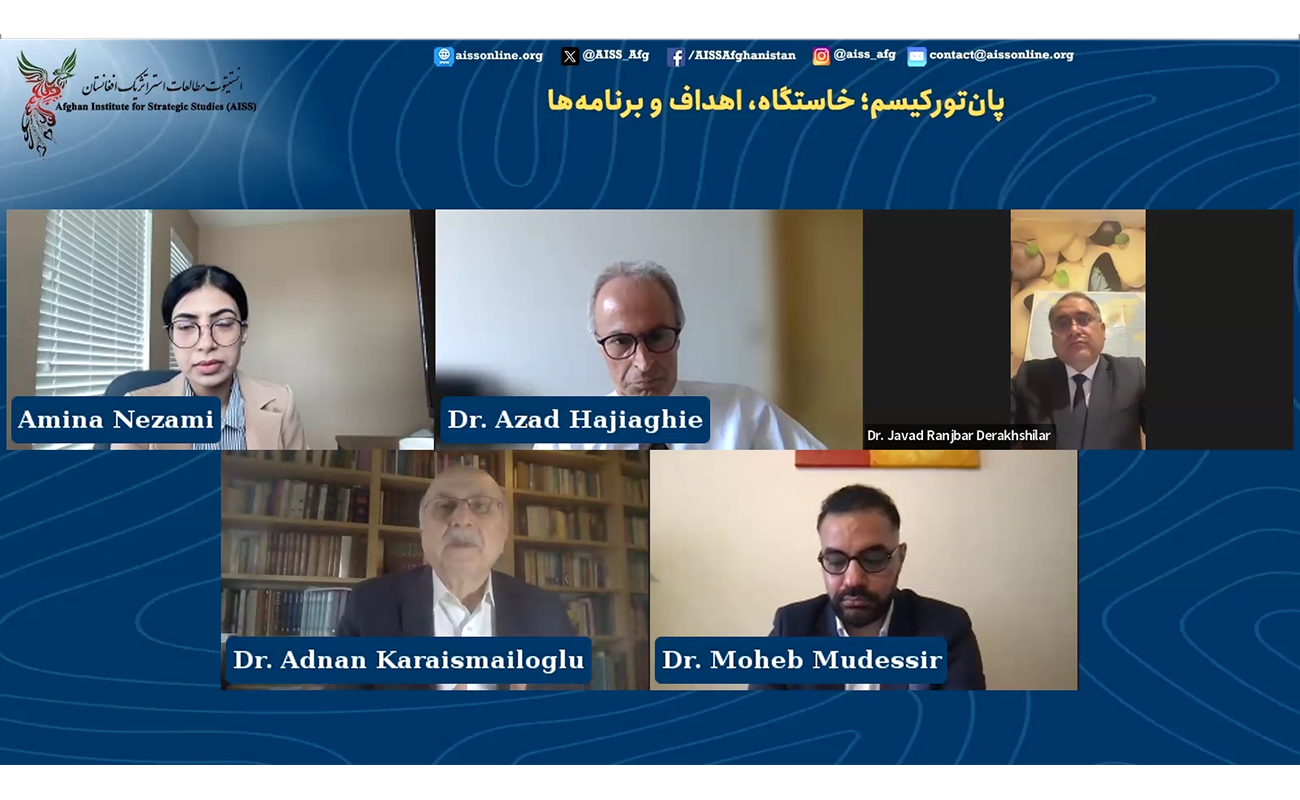Webinar: Pan-Turkism: Origins, Goals, and Agendas
On Sunday, April 13, the Afghan Institute for Strategic Studies hosted a webinar titled “Pan-Turkism: Origins, Objectives, and Agendas.” The discussion brought together scholars, writers, and researchers from Afghanistan, Turkey, and Iran to examine one of the region’s most contentious identity discourses - a political project that, drawing on linguistic, cultural, and historical ties among Turkic-speaking peoples, seeks to construct a new supranational framework for unity and a redefinition of power. Key themes in the conversation included Pan-Turkism’s entanglement with nationalism, its intersections and frictions with Islamist movements, its potential for coexistence or conflict with other ethnic and linguistic groups, and its evolving role in the politics of modern states.
Dr. Azad Hajiaghaie opened the discussion by distinguishing between “ideology” and “discourse,” noting that Pan-Turkism, as a discourse, is a shifting constellation of symbols, concepts, and strategies shaped by various historical conditions. He traced its roots to 19th-century reactions against Pan-Slavism, highlighting figures such as Ármin Vámbéry, Yusuf Akçura, and Ismail Gasprinsky as pioneers. According to Dr. Hajiaghaie, Pan-Turkism was not a product of Islamic thought, but rather a reactionary idea shaped by the Western imperial order.
Dr. Javad Ranjbar Derkheshilar situated Pan-Turkism as a continuation of the Pan-Islamic project that emerged under the pressures of colonialism and European modernity. Referring to figures like Seyyed Jamal al-Din Asadabadi, he argued that Pan-Turkism gradually abandoned Islamic unity in favor of a race-based ideology. He traced its intellectual lineage to Hungarian and Russian orientalists who emptied the ancient Persian notion of Turan of its original meaning and redefined it for the purposes of Turkish nationalism. According to Ranjbar, this ideological reframing has led to a systematic distortion of history - such as the appropriation of Sultan Mahmud of Ghazni from the Persianate tradition - which has become a defining trait of the Pan-Turkist narrative.
Dr. Moheb Mudessir approached the topic through a legal lens. While acknowledging that cultural and linguistic interaction among Turkic peoples is not inherently problematic under international law, he warned that Pan-Turkism becomes a threat when it adopts hegemonic or racialized dimensions. He argued that Pan-Turkism arose in response to Russian colonialism and that the nation-building projects of the 20th century often imposed monoethnic identities upon multiethnic states, marginalizing non-dominant communities. National narratives, he said, typically represent the dominant group and impose their language, symbols, and history on others. He noted that as long as cultural cooperation among Turkic peoples remains voluntary and free of discrimination, it does not conflict with human rights norms.
Professor Adnan Kara Ismailoğlu, drawing on historical and linguistic analysis, argued that Pan-Turkism is a product of the West, not Islamic culture. He explained that during the final phase of the Ottoman Empire, imported ideologies like nationalism and Pan-Turkism led to the emergence of three ideological currents across the Turkic world: Islamism, nationalism, and Ottomanism. None of these, he asserted, were rooted in the intellectual traditions of Islam. Instead, he offered the Persian-Arabic-Turkic cultural synthesis of the Ghaznavid and Seljuk periods as examples of civilizational coexistence - coexistence that Pan-Turkism, in his view, fundamentally undermines.
In the second half of the webinar, Dr. Hajiaghaie addressed the impact of Pan-Turkism on relations between Turkic and non-Turkic communities in Central Asia, highlighting the structural and ethnic violence that has accompanied this discourse - including the Armenian genocide as a direct consequence of its ideological posture. Dr. Mudessir then elaborated on the distinctions between cultural Pan-Turkism and racial nationalism, offering a historical review of Pan-Turkist movements in Central Asia and northern Afghanistan. He noted that early expressions of Turkic unity were more cultural and Islamic in nature, particularly in resistance to Russian imperialism. Mudessir also criticized the erasure of Turkic identities in modern Afghanistan and the gradual exclusion of their language and culture from the state’s political architecture.
Dr. Ranjbar raised the alarm about Pan-Turkism being used as a political and military tool, warning that it lacks cultural substance and instead relies on exclusion and the suppression of non-conforming groups. He cautioned that if left unchecked, this discourse could usher in a violent future for the region. He argued explicitly that “Turkish history and culture must be rescued from the hands of Pan-Turkists.” In closing, Professor Adnan reiterated the importance of shared linguistic and cultural heritage across the region. He rejected militant ethnonationalism and underscored the centuries-long coexistence among Turks, Persian speakers, Arabs, and other peoples of the region. To him, the way forward lies in reclaiming those common roots and rejecting totalitarian ideologies.
The final segment of the webinar addressed questions from the audience concerning the feasibility of Pan-Turkist projects in multiethnic countries like Afghanistan and Iran, as well as its implications for minority rights and the risk of ethnonationalist conflicts. Dr. Hajiaghaie responded by emphasizing that any “Pan” project devoid of democratic values carries a latent potential for violence. Dr. Ranjbar concluded by stating that Pan-Turkism is, at its core, a political and militaristic ideology - not a cultural one - and its continuation will only deepen regional instability and lead to further unrest.

